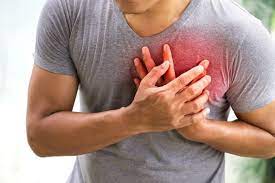MYOCARDIAL INFARCTION ( HEART ATTACK):
Myocardial Infarction is a condition performing from dropped blood and oxygen force to the heart, causing cell death. The major cause is unforeseen blockage of coronary arteries. Coronary arteries are blood vessels which supply the blood and oxygen to the heart muscles. Blockage of coronary arteries deprives the heart muscle of blood and oxygen, causing injury to the heart muscle causing casket pain and casket pressure sensation. However, unrecoverable death of the heart muscle will begin to do, If blood inflow isn’t restored to the heart muscle within 20 to 40 twinkles. Muscle continues to die for six to eight hours at which time the heart attack generally is” complete.” The dead heart muscle is ultimately replaced by scar tissue.
MYOCARDIAL INFARCTION CAUSES:
Myocardial infarction( MI) is the unrecoverable death( necrosis) of heart muscle which generally results from an imbalance in oxygen force and demand, which is most frequently caused by shrine rupture with a thrombus conformation in an epicardial coronary artery, performing in an acute reduction of blood force to a fraction of the myocardium. Acute MI is the single most common cause of death in bucolic nations. Among fatal cases, nearly half of the cases die before reaching the sanitarium. Major threat factors include former cardiovascular disease( similar as angina, a former heart attack or stroke), aged age( especially men over 40 and women over 50), tobacco smoking, high blood situations of certain lipids((triglycerides, low-viscosity lipoprotein or “bad cholesterol”) and low levels of HDL (“good cholesterol”), diabetes, high blood pressure, chronic renal failure, excessive alcohol use, high stress level, heart failure, addiction or abuse of certain medications ( such as cocaine and methamphetamine).
MYOCARDIAL INFARCTION SYMPTOMS:
Cases with typical MI may have the following symptoms in the days or indeed weeks antedating the event Fatigue, casket discomfort, Malaise.
Usually chest pain in acute MI includes the following characteristics,
- Violent and running for 30- 60 twinkles.
- Sub sternal, and frequently radiates up to the neck, shoulder, and jaw, and down
the left arm. - Generally described as a sub sternal pressure sensation that also may be
characterized as squeezing, paining, burning, or indeed sharp. - In some cases, the symptom is epigastric, with a feeling of indigestion or of
wholeness and gas. Other symptoms of myocardial infarction include the following - Anxiety, generally described as a sense of brewing doom
- Arms, left shoulder, back, and other body parts may experience pain or discomfort. The neck, the mouth, or the stomach
- Light- headedness, with without syncope
- Cough
- Nausea, with or without vomiting
- Gushing sweating.
- Difficult of breath
- Gasping
- Rapid or irregular heart rate
- Wholeness, indigestion, or choking
MYOCARDIAL INFARCTION TREATMENT:
The primary thing of the treatment is to first open the blocked artery and restore blood inflow to the heart muscle. This process is called reperfusion. As the reperfusion takes place also the case will sluggishly get relieved from the pain. The early reperfusion i.e. within 4- 6 hours of the heart attack can’t only help further damage to the heart but also preserves the pumping action of the heart. The damage to the pumping action of the heart develops heart failure, dropped capability to exercise, and abnormal heart measures.
Exigency agents: exigency agents are those which are used in the process of
reperfusion of the heart muscle. These agents principally help in relieving the
severe heart pain, beget Vasodilatation to open the blocked artery. Restore the
oxygen force and help the farther damage of the heart muscle. These agents are
morphine, oxygen, nitroglycerine, aspirin.
Anti-platelet agents: Anti-platelet specifics help conformation of blood. Clots in the
highways. In NSAID, aspirin inhibits cyclooxygenase- 1 enzyme and therefore
prevents blood clotting by blocking the product of thromboxaneA-2 by platelets,
the chemical that causes platelets to clump. In addition to thromboxaneA-2,
platelets also produce adenosine diphosphate( ADP), which when acts on its
receptor causes cementing of the platelets. The thienopyridines, clopidogrel, block the ADP receptor therefore precluding the platelets from cementing.
Anti-coagulants: Anti-coagulant specifics help growth of blood clots in the arteries.
Anti-coagulants similar as intravenous or subcutaneous heparin, subcutaneous low molecular weight heparin, and oral warfarin, help the conformation of blood clots either by inhibiting the product of clotting factors or by snooping with the action of the clotting factors. Enoxaparin.
Clot- dissolving specific Fibrinolytic or thrombolytic agents are known as clot
dissolving agents used to open blocked arteries and dissolve the being clots.
Intravenous administration of similar tissue clot- dissolving medicines similar to
plasminogen activator( TPA) or TNK can open up to 80 of acutely blocked coronary arteries. Medicines similar as streptokinase can be used for breaking up or dissolving the clots by converting the natural plasminogen present in the fibrin clot to its active agent form plasmin.
B- adrenergic receptor blockers: B- blockers act by dwindling the workload of the
heart. Drop in the workload decreases the demand for oxygen by the heart and
limits the quantum of damage to the heart muscle. Long- term administration of B blockers following a heart attack has been shown to ameliorate survival and reduce the threat of unborn heart attacks. Esmolol, Propranolol, Atenolol, Timolol.

